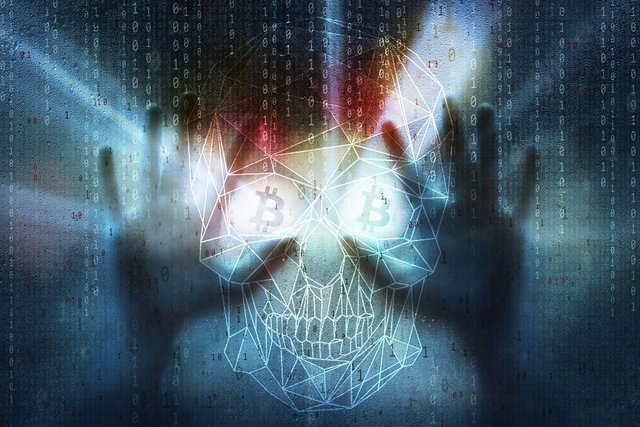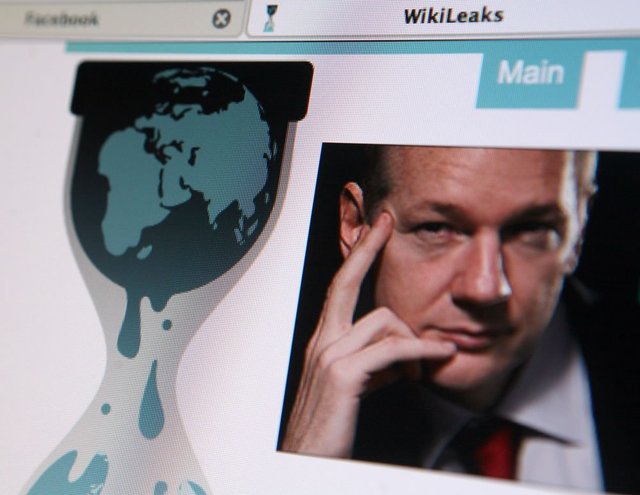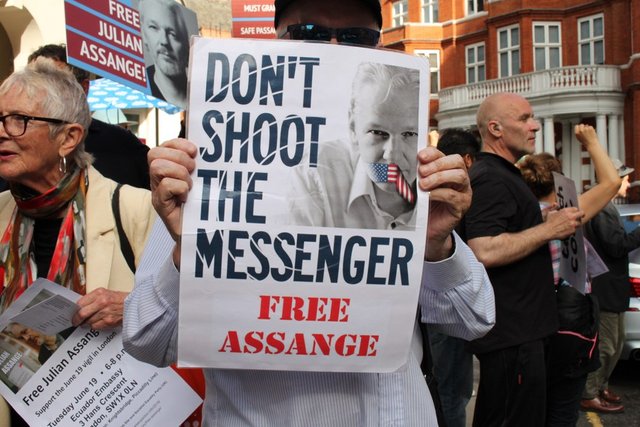Change the world from anonymity; Cypherpunks and Julian Assange
The possibilities offered by an interconnected world are virtually infinite. Generate and consume content, share and expand the baggage of information that circulates on the web is what we do with everyday, be aware of the risks or not.

The digital native uses the media and the Internet as a source and at the same time a channel to transmit encrypted messages as simple as a "good morning" or as complex as making virtual money transactions.
However, younger generations, despite understanding and using technology that allows access to the complex and complex network of web systems, do not perceive the prevailing "vigilante" faculty possessed by 2.0 media.
More than a medium or a channel, we could catalog the World Wide Web, as a mediator. An intermediary that is responsible for sending and receiving packages (information), from one or several points to others. However, the genius of the system that has revolutionized the world has a cost; the broker can see what the packages contain.
It is the equivalent of sending a letter and having the postman read it. In fact, read all the letters, photos, and basically all the sensitive information that you do not want others to see.
Privacy is a sensitive issue
The Internet was positioned as the indispensable de facto tool to work, study, even make life. Consider that, to be a "connected" person you must sacrifice the right to privacy is an idea that did not stop haunting the head of a group of individuals who felt that this system was not for them.
The asymmetric encryption was discovered in the 70s, however it was not until the early 90's, when it could be used freely. It was here that Eric Hughes, Tim May and John Gilmore, a mathematician, entrepreneur and computist, respectively, young retirees, began to meet to discuss the programming and encryption problems that afflicted the world at that time.
In one of the meetings, held at Cygnus Solutions, Gilmore's company, Jude Milhon, hacker and author, better known by his pseudonym "St Jude", gave the group the name of "Cypherpunks", a word game between encryption (cypher) and the musical movement of protest emerged in England during the 80s that expanded to other areas, the punks, and then, cyberpunks, by science fiction writers.
From there, a whole movement would emerge
The cypherpunks would use asymmetric encryption as a basis to share information and initiate discussions with cypherpunks from all over the world, through a select mailing list. The meetings, whose scenario, now was the web, were free of third-party monitoring and surveillance.
The movement gained strength and grew rapidly
The discussions held in the chats were of all kinds. There were political, philosophical, sociological, as well as technological and financial discussions. It was difficult to reach a solid conclusion in whatever were the topics of debate of these matters, however, what if it was accurate and true was the guarantee of freedom of expression and privacy offered by those forums. In this way, it arises, thanks to computer science, along with the social reason of protecting privacy, an ideology.
The aim of the Cypherpunks was to prevent the loss of privacy, or rather, protect individual freedom on the web, through cryptography.

Pray a fragment of the "Cypherpunk Manifesto" written by Eric Hughes in 1993:
"Privacy is necessary for an open society in the electronic age. Privacy is not secret. A private matter is something that one does not want everyone to know, but a secret matter is something that one does not want anyone to know. Privacy is the power to reveal itself selectively to the world. "
The emphasis of the whole movement was privacy, including the way it was reflected in transactions, as this other passage points out.
When I buy a magazine in a store and give cash to the employee, there is no need to know who I am. When I ask my email provider to send and receive messages, my provider does not need to know who I am talking to or what I am saying or what others are telling me; my provider just needs to know how to send the message there and how much do I owe them in commissions ...
Therefore, privacy in an open society requires anonymous transaction systems. So far, cash has been the main system of this type. An anonymous transaction system is not a secret transaction system. An anonymous system allows people to reveal their identity whenever they want and only when they want; This is the essence of privacy.
In essence, the cypherpunks, are activists, liberal or anarchist court that seek to forge a utopia that uses anonymity, freedom of expression, free trade and culture as the basis, the vehicle to achieve this would be a website managed by them, which governments could not supervise.
The movement continued to expand along with advances in telecommunications, thus empowering more and more people who with only access to a computer could rival the policies of censorship and control of governments to traffic sensitive information. In this way, the sense of social struggle and the impetus to find the truth was the standard by which many Cypherpunks were seized by the law.
Among those individuals it is worth highlighting the figure of one who was and continues to be a cause of controversy in the world: Julian Assange.

Julian Assange
As is to be expected of a man who lives by anonymity, the early life of this controversial Australian is largely unknown. The details that are known are usually mere speculations. In his own words, Assange states that he attended more than 37 different schools and five universities, in the same way, from a very young age he belonged to groups of hackers.
In spite of everything, Assange is a capable self-taught person with knowledge in mathematics, computer science, electronics, physics as well as in neuroscience and philosophy, which would indicate a strong inclination to know the human being in thought.
It is, undoubtedly, the representation of the Cypherpunk movement
Assange's career as a hacktivist goes back to the early 90s, with remarkable achievements, however, it is in 2006 when he founded and starts to direct Wikileaks.
WikiLeaks is a non-profit organization dedicated to publishing sensitive documents with valuable information from organizations and governments around the world, whose main attraction is respect for the anonymity of sources.
It is the cornerstone that would take the Cypherpunk movement to the next level. The struggle for privacy can, in large part, be reflected in the joint efforts of all the anonymous contributors who have made Wikileaks a flagship institution for ethics, journalism, and high security technology.
Due to its great potential and drive, Wikileaks has received, from the moment of its creation, numerous legal attacks from governments and entities of global weight, harmed by its controversial publications, crude, but endowed with truthfulness.
Julian Assange, ironically, soon became the face of truth
It was in 2010, when a Swedish court denounced the Australian for rape and harassment in Sweden, which would lead to a series of problems that would eventually end in the country's flight to London, limiting the activity of Assange.
That same year WikiLeaks published half a million files, related to the wars of the United States in Iraq and Afghanistan. The then president, Barack Obama, criticized the leaks as a threat to national security, projecting Julian Assange as an enemy of the world.

The Cypherpunks around the world quickly highlighted that the accusations were a plot to delegitimize the figure of Assange, who after a year of trial, requested asylum in the Ecuadorian Embassy, where he lives to this day.
Assange is currently the axis and central figure of the Cypherpunk movement, along with the also pursued Edward Snowden. With several publications and informative material about him, Julian Assange has sacrificed his own anonymity, for that of the hundreds of thousands of WikiLeaks collaborators, getting to write "Julian Assange: The Unauthorized Autobiography" where, he shares the experiences and situations that They took him to sacrifice his freedom for the project that was inspired by clandestine meetings in the early 90s.
A year later in 2012, he published together with Jacob Appelbaum, Andy Müller-Maguhn and Jérémie Zimmermann, cypheractivists the book "Cypherpunks: The freedom and the future of the Internet" that would become the text par excellence of the movement, together with the manifesto by Eric Hughes.
Today more than ever, the younger generations are aware of the struggle of the Cypherpunks, following in the footsteps of Assange and all the forerunners of the struggle for anonymity and privacy, denouncing with force the totalitarian control exercised by the states.
Given this problem, for cypherpunks, it seems that problems have the same solution as 20 years ago; the cryptography.
Congratulations! This post has been upvoted from the communal account, @minnowsupport, by Rusinho027 from the Minnow Support Project. It's a witness project run by aggroed, ausbitbank, teamsteem, theprophet0, someguy123, neoxian, followbtcnews, and netuoso. The goal is to help Steemit grow by supporting Minnows. Please find us at the Peace, Abundance, and Liberty Network (PALnet) Discord Channel. It's a completely public and open space to all members of the Steemit community who voluntarily choose to be there.
If you would like to delegate to the Minnow Support Project you can do so by clicking on the following links: 50SP, 100SP, 250SP, 500SP, 1000SP, 5000SP.
Be sure to leave at least 50SP undelegated on your account.